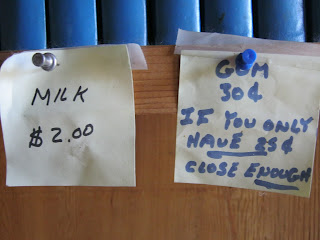I thought I came from a small town until I visited
Wiseman. It’s hard to imagine a
community of about a dozen people until you walk through one.
Wiseman, founded in the heyday of the Alaskan and Yukon Gold
Rushes, has been a small, but stable community for over 100 years now and
counting. Robert Marshall wrote about
the town as it existed in 1930-31 for his book Arctic Village. Here are
some of the things I've noticed that have changed since Marshall’s
observations:
Snowmobiles (“snow machines”) have mostly replaced dogsleds
for winter transportation. In winter,
nearly all (if not all) creeks and rivers, including the mighty Yukon to the
south, completely freeze over, becoming convenient highways for light
transport. Rivers are not without their
perils, including thin ice and overflow, however. Overflow is what happens when the pressure of
the water under the ice becomes great enough to break through the surface and
run over the top of the ice before eventually freezing again. This liquid water can be difficult to spot,
and getting wet in subzero temperatures can be life-threatening. Even sweating when the air is -40 degrees
Fahrenheit can lead to hypothermia.
The Dalton Highway has allowed for automobile transportation
year-round. The first automobile
appeared in Wiseman sometime in the 1920s, and it was largely seen as a
novelty. It wasn't useful for transport
in winter, it got stuck in the mud… it simply wasn't a better option than
transport by sled, boat, horsepower, or even backpacking on foot in most
circumstances. However, at least since
the construction of the highway and pipeline, 4-wheel drive vehicles are
commonplace, though sleds, boats and planes are still used by some.
Most homes seem to have access to electricity and propane
for modern refrigeration, cooking, heating, and other labor saving or
entertainment devices. However, there is
no cell service and little running water. Electricity, when available, is produced by
homeowners’ windmills (which charge arrays of batteries) or fuel-burning
generators.
Most residents are no longer mining for gold, although a few
do. Most offer lodging, provide tours
and hunting guide services, and/or work elsewhere, such as the AIVC in
Coldfoot. Many save money through
subsistence hunting, trapping, fishing, and gathering. By hunting moose and other game, rural residents
can acquire meat to eat and fur or hide to sell. One resident turns fangs into jewelry to
stretch the value of his kills. For
produce, it is possible to grow vegetables during the long, occasionally
endless days of summer. Because of the
long days, vegetables can actually grow to incredible sizes. Potatoes, for instance, can apparently grow
quite large, though Bob Marshall’s Wiseman residents called them “waterballs,”
since most of their excess girth was extra water weight, and these turned into
husks when baked. Potatoes and other
root vegetables can be stored easily through winter, but leafy greens are
impossible to grow or store through the dark months. One modern resident lamented that in winter
he “dreams of salad.”
Airplane service is far more common, but not new since
Marshall’s visit. The first plane
touched down in Wiseman in the middle of the 1920s, and it was a
sensation. Airplanes were used by
wealthier residents to get to and from Fairbanks, or by anyone else if it was
necessary to get to the nearest hospital, again in Fairbanks (this is still
true today). A telegraph service was set
up by the U.S. government (as I recall) for the primary purpose of calling for
air transport if it was needed. Today,
at least one resident owns a plane and knows how to fly it, and I saw one or
two others that looked usable. And
purchasing a flight is likely (I haven’t checked) less of a portion of a
person’s yearly income today than it was in 1930.
I can't think of much else that hasn't also changed for
everyone throughout the U.S. in the last 85 years. Wiseman is still largely isolated from the
rest of the world. The residents today
have a pretty similar diet. The
community is still extremely close-knit, nearly to the point of being family, although
two households are actually family. In
1930, it was common for everyone to pool their resources to help a community
member in need, such as buying a plane ticket to the hospital for a girl whose
father spends all the family’s money on booze and gambling. Today, I haven't heard if such generosity
still exists in that form, but neighbors in Wiseman seem to be quite neighborly.
That said, living in Wiseman requires a certain mindset, one
accustomed to solitude, and the locals seem to value maintaining their distance
from the world at large. It’s almost
paradoxical how friendly and guarded people can be at the same time, but I just
think a person needs to earn the trust of the residents here, which is true
pretty much everywhere in the world I've been.
I won't say much else, partly because I haven't been here
long enough, partly because I'm not used to trying to explain human behavior, and
largely because I haven't asked permission to write about anyone by name or
conducted any interviews of my own. But
I hope this serves as an introduction for your own further reading, should you
be interested.
Thanks for reading.
-Rob
Bonus: the Wiseman Trading Post












No comments:
Post a Comment